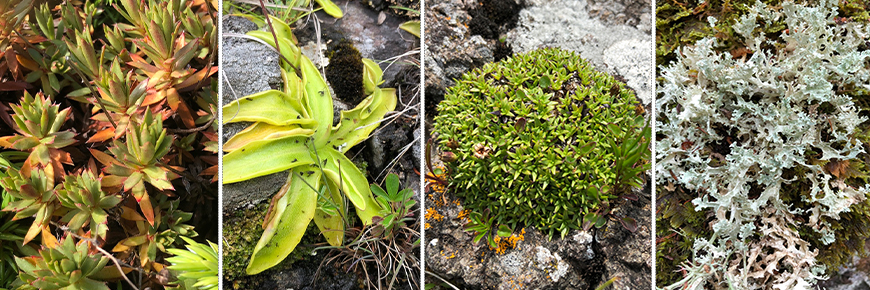
Meet the coolest plants on the north shore
Lake Superior National Marine Conservation Area
By Kimberly Teager and Douglas Tate
Have we mentioned how cool coastal plant communities are? In the fall edition of shoreLINES, we shared why the north shore of Lake Superior is one of very few places you can find arctic-alpine plants in the Great Lakes Region. We also described the efforts made by Parks Canada staff to expand the list of known species found in Lake Superior National Marine Conservation Area (NMCA). This begs the question…what did we find?
Saxifrages look like a desert succulent you might receive as a house-warming gift; however some local species are well adapted to cooler climates. The thick water-storing leaves of Prickly Saxifrage (Saxifraga tricuspidata) turn a vibrant red with the onset of winter, when its seeds are released and carried great distances by strong winds. In Ontario, this species typically grows in the Hudson Bay Lowlands, but a few isolated populations have been found on islands off the Black Bay Peninsula.
Common Butterwort (Pinguicula vulgaris) is not only cool because of where it lives, but how it lives. You may have heard of carnivorous plants that “consume” insects and other small organisms for essential nutrients. Most examples grow in wetland soils that lack nitrogen and phosphorus. Unlike these bog-dwellers, butterworts can grow on exposed bedrock, around the edges of splash pools, or high up and away from big waves in cracks along cliff faces. Some say their leaves look like tiny banana peels, but rather than being slippery, these leaves produce a sticky fluid and enzymes to trap and digest their prey.
Unknown to exist anywhere else in the Great Lakes Basin, Moss Campion (Silene acaulis) has found refuge on a single island in Lake Superior. In the Arctic, it is sometimes called Compass Plant because flowers first appear on its south-facing side, where the earliest rays of spring sunshine strike the plant. The evergreen leaves and branches spread out in an aerodynamic cushion-like shape that provides protection from winter winds threatening to dry it out. The poet William Wordsworth (1807) describes it best…
"There, cleaving to the ground, it lies
With multitude of purple eyes,
Spangling a cushion green like moss."
Lichens are not plants at all, but still key members of arctic-alpine communities. Although they look a lot like moss, lichens are made up of fungi in partnership with algae or cyanobacteria. Crinkled Snow Lichen (Flavocetraria nivalis) is a treat to see because so few of them have been found in Ontario. It hides in rock crevices here and there along the north shore, and can also be found in Hudson Bay’s maritime tundra.
These are just a few examples of many cool plants (and lichens) found in Lake Superior NMCA that usually grow in arctic or alpine habitats. Most are small and easy to miss on the bedrock, shadowed by rock ledges, or hidden among mosses and other plants. So when you are out exploring Lake Superior’s north shore, please be mindful of where you step! If you are lucky enough to find them, don’t hesitate to share your observations on iNaturalist!
Back to shoreLINES
- Date modified :